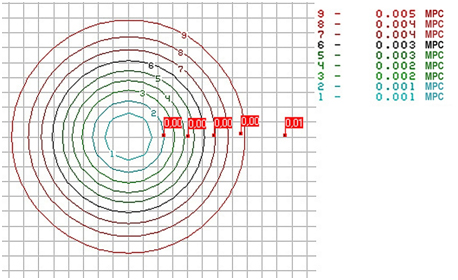Measurement of nitrogen oxide (NOx) emissions in fuel-combustion equipment and analysis of their impact on city air condition
DOI:
https://doi.org/10.15587/2706-5448.2023.282624Keywords:
pollutant emissions, nitrogen oxides, gas analyzer, emission dispersion map, hygienic standards of atmospheric airAbstract
The object of the research is to ensure environmental safety and maximum efficiency of fuel burning equipment. Energy facilities (thermal power plant, boiler houses) are among the biggest air polluters in the city. Nitrogen oxides (NO, NO2, NOx) occupy a significant place among the toxic gases contained in the flue gases of fuel-burning equipment. These substances have a negative impact on the ecological state of the city and are regulated by the Order of the Ministry of Natural Resources of Ukraine dated 27.06.2006 No. 309 on the approval of standards for maximum permissible emissions of pollutants from stationary sources. The principles of measurement unity are considered, including the presentation of measurement results in standard units (ppm, mg/m3). Conversion from volume concentration (ppm) to mass (mg/m3) is given. Measurements of the concentration of nitrogen oxides were carried out. In the course of research, instrumental measuring tools were used, which made it possible to obtain the values of nitrogen dioxide concentrations in gas boiler flue emissions. In particular, the average maximum concentrations of the main pollutants exceed 62.58 mg/m3. Analyzing the concentration of flue gases allows to determine the concentration of pollutants and to adjust the optimal operation of the equipment as much as possible, achieving a reduction in emissions and compliance with the approved emission standards. Obtained data on background concentrations of nitrogen dioxide in the city of Kyiv, amounting to 1.33 MPC. Using the data of instrumental measurements with the method of calculating concentrations of harmful substances in the atmospheric air and background concentrations, a map of emission dispersion was created. Fields of surface concentrations were plotted on the scattering map, which makes it possible to compare the obtained values with the hygienic standards of atmospheric air. By combining instrumental measurement methods and calculation methods, the volume of emissions was determined and the impact on atmospheric air pollution of the city was assessed.
References
- Rohozhyn, O. H., Khlobystov, Ye. V., Yakovlev, Ye. O. (2015). Informatsiinyi instrumentarii otsinky ekolohichnykh resursiv v Ukraini. Matematychne modeliuvannia v ekonomitsi, 3, 13–26.
- Meghea, I., Mihai, M., Demeter, T. (2013). Gauss dispersion model applied to multiple punctual sources from an industrial platform. International Multidisciplinary Scientific GeoConference: SGEM: Surveying Geology & Mining Ecology Management, 1, 497.
- Hromova, O. V. (2004). Analiz modelei poshyrennia rechovyn v atmosferi vid statsionarnykh dzherel. Naukovi pratsi UkrNDHMI, 253, 173–181.
- Pliatsuk, L. D., Bataltsev, Ye. V. (2012). Increasing of environmental safety of thermal power plants by coal gasification technology. Ekolohichna bezpeka, 2, 90–92.
- Prymiskyi, V. P., Ivasenko, V. M., Korniienko, D. H. (2014). Adaptation features and emission standards execution control in the industry. Eastern-European Journal of Enterprise Technologies, 3 (1 (69)), 8–16. doi: https://doi.org/10.15587/1729-4061.2014.24973
- Prymiskyi, V. P. (2011). Instrumentalnyi kontrol kontsentratsii dymovykh haziv i tekhnolohichna optymizatsii protsesiv horinniaiu. Metrolohiia ta prylady, 1, 61–67.
- Korniienko, D. H., Prymiskyi, V. P. (2015). Automatic cleaning system of sample preparation of flue gas tester. Technology Audit and Production Reserves, 1 (3 (21)), 29–32. doi: https://doi.org/10.15587/2312-8372.2015.37029
- Miheeva, I. L., Grabar, V. Ia., Valtsev, V. A., Mazyra, L. D. (2015). Mnogokomponentnyi hemiliuminestsentnyi gazoanalizator. Sovremennye informatsionnye i elektronnye tekhnologii, 2, 200–201.
- DSTU 8812:2018. Yakist povitria. Vykydy statsionarnykh dzherel. Nastanovy z vidbyrannia prob (2018). Available at: https://zakon.isu.net.ua/sites/default/files/normdocs/dstu_8812_2018.pdf
- DSTU 8725:2017. Yakist povitria. Vykydy statsionarnykh dzherel. Metody vyznachennia shvydkosti ta obyemnoi vytraty hazopylovykh potokiv (2017). Available at: http://www.ksv.biz.ua/GOST/DSTY_ALL/DSTU4/dstu_8725-2017.pdf
- Pokaznyky emisii vykydiv zabrudniuiuchykh rechovyn v atmosferne povitria. Vol. 1-3 (2008). Donetsk: IATs VAT «UkrNTEK», 466.
- Jol, A., Kielland, G. (Eds.) (1997). Air pollution in Europe 1997. Executive summary. Copenhagen: European Environment Agency.

Downloads
Published
How to Cite
Issue
Section
License
Copyright (c) 2023 Vitaliy Ivasenko

This work is licensed under a Creative Commons Attribution 4.0 International License.
The consolidation and conditions for the transfer of copyright (identification of authorship) is carried out in the License Agreement. In particular, the authors reserve the right to the authorship of their manuscript and transfer the first publication of this work to the journal under the terms of the Creative Commons CC BY license. At the same time, they have the right to conclude on their own additional agreements concerning the non-exclusive distribution of the work in the form in which it was published by this journal, but provided that the link to the first publication of the article in this journal is preserved.







